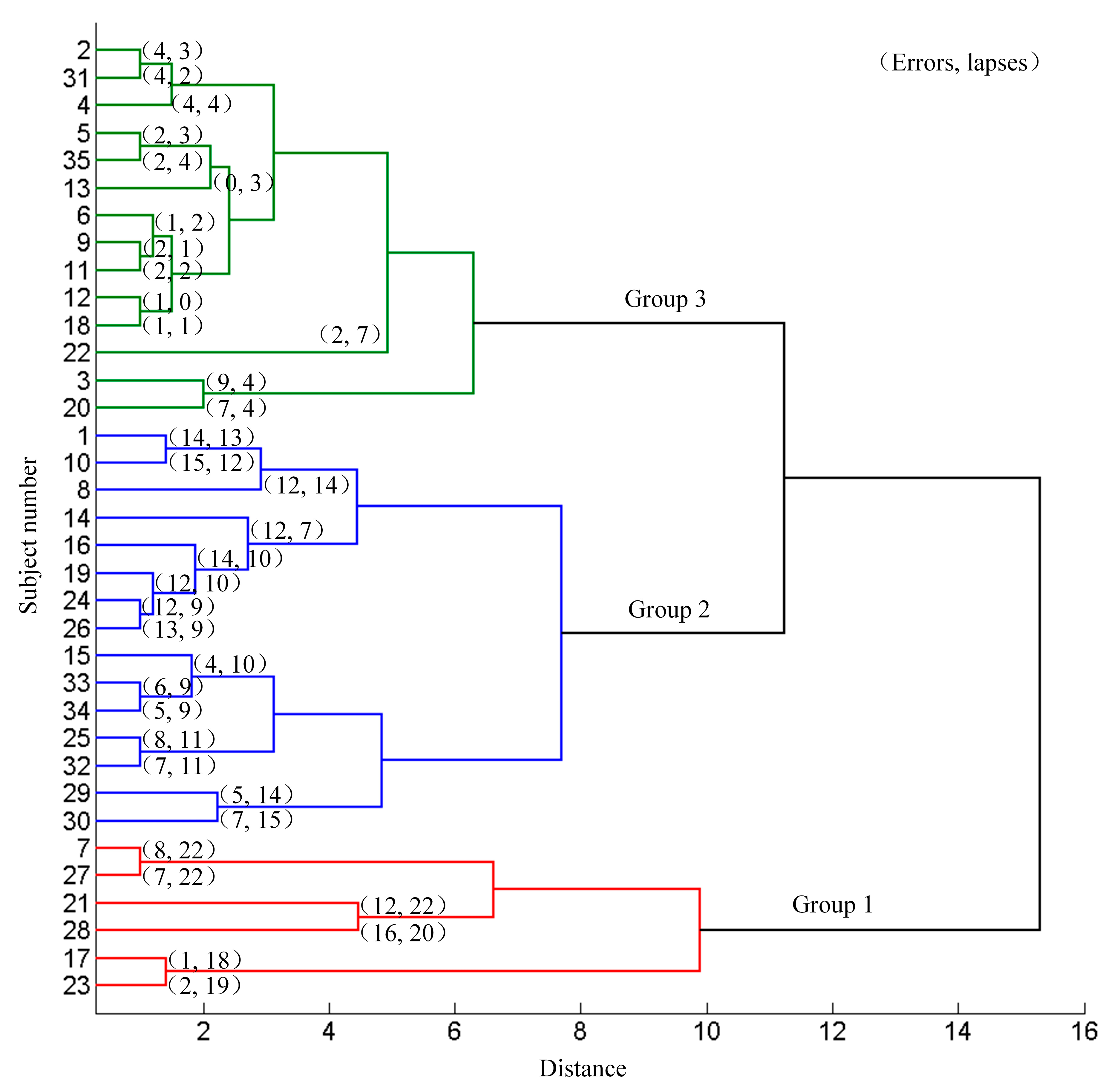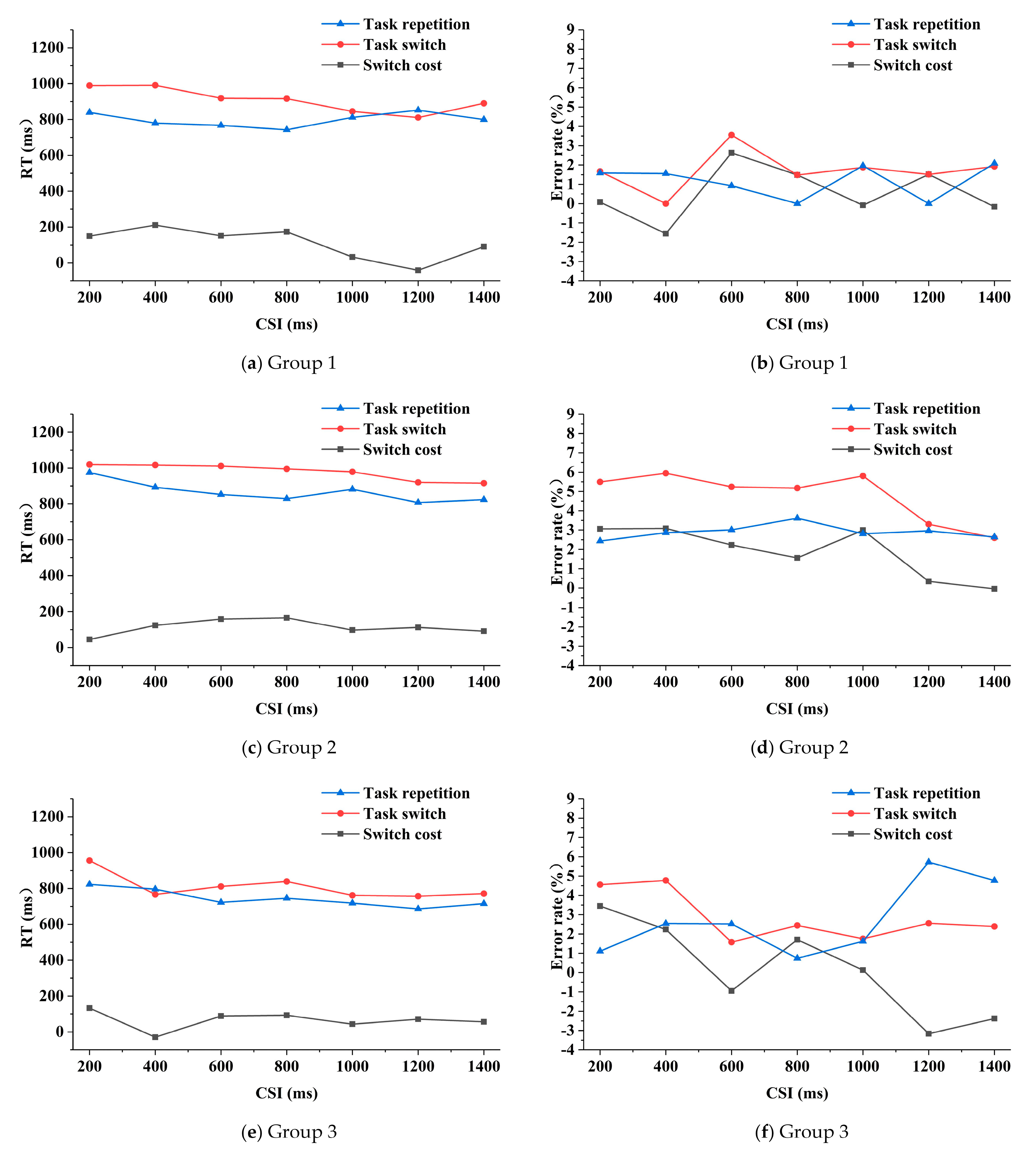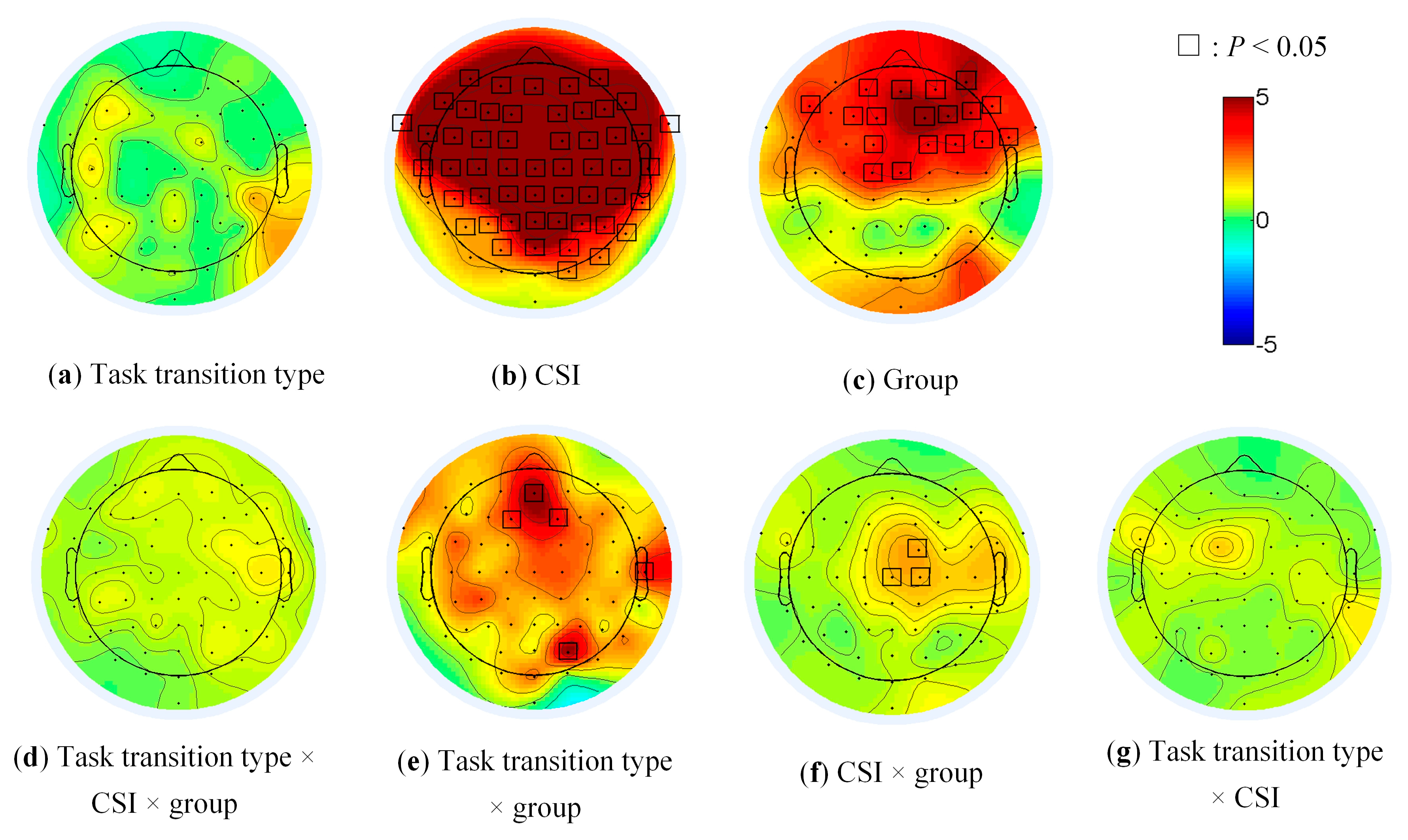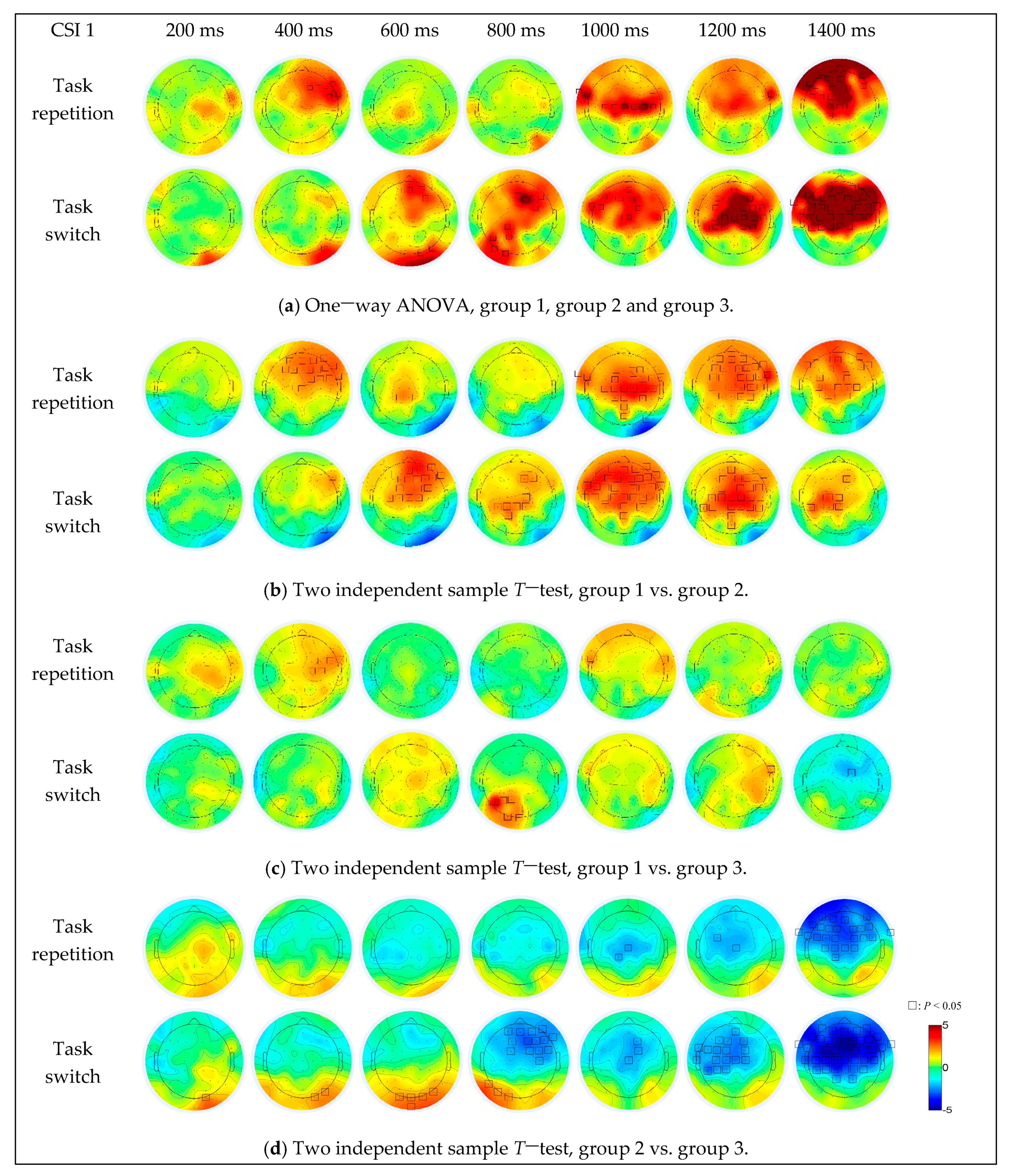An Evaluation of Executive Control Function and Its Relationship with Driving Performance
Abstract
1. Introduction
2. Materials and Methods
2.1. Method Overview
2.2. Subjects and Experiment Design
2.3. Data Acquisition
2.4. Analysis of Behavioral Data
2.5. Analysis of EEG Data
3. Results
3.1. Behavioral and EEG Characteristics of Different Groups of Subjects
3.1.1. Grouping Results
3.1.2. Effect of Task Transition Types, CSIs and Group on the Behavioral Data
3.1.3. Effect of Task Transition Types, CSIs and Group on the EEG Data
4. Discussion
4.1. Relationship between Driving Performance and Executive Control Efficiency
4.2. The Underlying Cerebral Network for the Executive Control Function
4.3. Effect of CSI Level on the Brain Activities
4.4. Novelty and Limitations
5. Conclusions
Author Contributions
Funding
Institutional Review Board Statement
Informed Consent Statement
Data Availability Statement
Acknowledgments
Conflicts of Interest
References
- Sta, G. Global status report on road safety. Inj. Prev. 2015, 15, 286. Available online: https://www.afro.who.int/publications/global-status-report-road-safety-2015 (accessed on 1 February 2021).
- Singh, S. Critical Reasons for Crashes Investigated in the National Motor Vehicle Crash Causation Survey; No. DOT HS 812 115; 2015. Available online: http://www-nrd.nhtsa.dot.gov/Pubs/812115.pdf (accessed on 1 February 2021).
- Lerner, N.; Robinson, E.; Singer, J.; Jenness, J.; Huey, R.; Baldwin, C.; Fitch, G. Human Factors for Connected Vehicles: Effective Warning Interface Research Findings. Available online: https://www.nhtsa.gov/sites/nhtsa.dot.gov/files/812068-humanfactorsconnectedvehicles.pdf (accessed on 20 February 2021).
- Smith, A.P. A UK survey of driving behaviour, fatigue, risk taking and road traffic accidents. BMJ Open 2016, 6, e011461. [Google Scholar] [CrossRef] [PubMed]
- Walker, H.E.; Trick, L.M. Mind-wandering while driving: The impact of fatigue, task length, and sustained attention abilities. Transp. Res. Part F Traffic Psychol. Behav. 2018, 59, 81–97. [Google Scholar] [CrossRef]
- Garner, A.; Fine, P.R.; A Franklin, C.; Sattin, R.W.; Stavrinos, D. Distracted driving among adolescents: Challenges and opportunities. Inj. Prev. 2011, 17, 285. [Google Scholar] [CrossRef]
- Jimenez-Moreno, R.; Orjuela, S.A.; Van Hese, P.; Prieto, F.A.; Grisales, V.H.; Philips, W. Video surveillance for monitoring driver’s fatigue and distraction. Photonics Eur. 2012, 8436, 84360. [Google Scholar] [CrossRef]
- Sigari, M.-H.; Pourshahabi, M.-R.; Soryani, M.; Fathy, M. A Review on Driver Face Monitoring Systems for Fatigue and Distraction Detection. Int. J. Adv. Sci. Technol. 2014, 64, 73–100. [Google Scholar] [CrossRef]
- Li, Z.; Li, S.E.; Li, R.; Cheng, B.; Shi, J. Online Detection of Driver Fatigue Using Steering Wheel Angles for Real Driving Conditions. Sensors 2017, 17, 495. [Google Scholar] [CrossRef]
- Deshmukh, S.V.; Dehzangi, O. ECG-Based Driver Distraction Identification Using Wavelet Packet Transform and Dis-criminative Kernel-Based Features. In Proceedings of the IEEE International Conference on Smart Computing, Hong Kong, China, 29–31 May 2007. [Google Scholar]
- Yan, L.; Wang, Y.; Ding, C.; Liu, M.; Yan, F.; Guo, K. Correlation Among Behavior, Personality, and Electroencephalography Revealed by a Simulated Driving Experiment. Front. Psychol. 2019, 10, 1524. [Google Scholar] [CrossRef] [PubMed]
- Jin, L.; Niu, Q.; Hou, H.; Xian, H.; Wang, Y.; Shi, D. Driver Cognitive Distraction Detection Using Driving Performance Measures. Discret. Dyn. Nat. Soc. 2012, 2012, 1–12. [Google Scholar] [CrossRef]
- Alavi, S.S.; Mohammadi, M.R.; Soori, H.; Ghanizadeh, M. The Cognitive and Psychological Factors (Personality, Driving Behavior, and Mental Illnesses) As Predictors in Traffic Violations. Iran. J. Psychiatry 2017, 12, 78–86. [Google Scholar]
- Go, R.; Wu, J.; Liu, Y.; Kuroda, Y.; Wu, Q. Cognitive Psychological Study on The Occurrence of Microsaccades in Visual Spatial Attention. In Proceedings of the 2018 IEEE International Conference on Mechatronics and Automation (ICMA), Changchun, China, 5–8 August 2018. [Google Scholar]
- Liu, M.; Zhang, J.; Jia, W.; Chang, Q.; Shan, S.; Hu, Y.; Wang, D. Enhanced executive attention efficiency after adaptive force control training: Behavioural and physiological results. Behav. Brain Res. 2019, 376, 111859. [Google Scholar] [CrossRef] [PubMed]
- Funahashi, S. Neuronal mechanisms of executive control by the prefrontal cortex. Neurosci. Res. 2001, 39, 147–165. [Google Scholar] [CrossRef]
- Shi, L.; Sun, J.; Xia, Y.; Ren, Z.; Chen, Q.; Wei, D.; Yang, W.; Qiu, J. Large-scale brain network connectivity underlying creativity in resting-state and task fMRI: Cooperation between default network and frontal-parietal network. Biol. Psychol. 2018, 135, 102–111. [Google Scholar] [CrossRef] [PubMed]
- Dibbets, P.; Evers, E.A.T.; Hurks, P.P.M.; Bakker, K.; Jolles, J. Differential brain activation patterns in adult attention-deficit hyperactivity disorder (ADHD) associated with task switching. Neuropsychology 2010, 24, 413–423. [Google Scholar] [CrossRef] [PubMed]
- Dove, A.; Pollmann, S.; Schubert, T.; Wiggins, C.J.; von Cramon, D.Y. Prefrontal cortex activation in task switching: An event-related fMRI study. Cogn. Brain Res. 2000, 9, 103–109. [Google Scholar] [CrossRef]
- Posner, M.I.; Rothbart, M.K. Research on Attention Networks as a Model for the Integration of Psychological Science. Annu. Rev. Psychol. 2007, 58, 1–23. [Google Scholar] [CrossRef] [PubMed]
- Corbetta, M.; Shulman, G.L. Control of goal-directed and stimulus-driven attention in the brain. Nat. Rev. Neurosci. 2002, 3, 201–215. [Google Scholar] [CrossRef]
- Braver, T.S.; Reynolds, J.R.; I Donaldson, D. Neural Mechanisms of Transient and Sustained Cognitive Control during Task Switching. Neuron 2003, 39, 713–726. [Google Scholar] [CrossRef]
- Brown, J.W.; Reynolds, J.R.; Braver, T.S. A computational model of fractionated conflict-control mechanisms in task-switching. Cogn. Psychol. 2007, 55, 37–85. [Google Scholar] [CrossRef] [PubMed]
- Logan, G.D.; Gordon, R.D. Executive Control of Visual Attention in Dual-Task Situations. Psychol. Rev. 2001, 108, 393–434. [Google Scholar] [CrossRef]
- Meiran, N. Modeling cognitive control in task-switching. Psychol. Res. 2000, 63, 234–249. [Google Scholar] [CrossRef] [PubMed]
- Monsell, S. Task Switching. Trends Cogn. Sci. 2003, 7, 134–140. [Google Scholar] [CrossRef]
- Rogers, R.D.; Monsell, S.D. Costs of a predictable switch between simple cognitive tasks. J. Exp. Psychol. 1995, 124, 207. [Google Scholar] [CrossRef]
- Cole, M.W.; Schneider, W. The cognitive control network: Integrated cortical regions with dissociable functions. NeuroImage 2007, 37, 343–360. [Google Scholar] [CrossRef] [PubMed]
- Jamadar, S.; Hughes, M.; Fulham, W.; Michie, P.; Karayanidis, F. The spatial and temporal dynamics of anticipatory preparation and response inhibition in task-switching. NeuroImage 2010, 51, 432–449. [Google Scholar] [CrossRef] [PubMed]
- Weiler, J.; Hassall, C.D.; Krigolson, O.E.; Heath, M. The unidirectional prosaccade switch-cost: Electroencephalographic evidence of task-set inertia in oculomotor control. Behav. Brain Res. 2015, 278, 323–329. [Google Scholar] [CrossRef] [PubMed]
- Menno, N.; Borst, J.P.; Hedderik, V.R.; Taatgen, N.A. Driving and Multitasking: The Good, the Bad, and the Dangerous. Front. Psychol. 2016, 7, 1–16. [Google Scholar] [CrossRef]
- Parker, D.; Reason, J.T.; Manstead, A.S.R.; Stradling, S.G. Driving errors, driving violations and accident involvement. Ergonomics 1995, 38, 1036–1048. [Google Scholar] [CrossRef]
- Monsell, S.; Mizon, G.A. Can the task-cuing paradigm measure an endogenous task-set reconfiguration process? J. Exp. Psychol. Hum. Percept. Perform. 2006, 32, 493–516. [Google Scholar] [CrossRef]
- Sakai, K. Task Set and Prefrontal Cortex. Annu. Rev. Neurosci. 2008, 31, 219–245. [Google Scholar] [CrossRef] [PubMed]
- Altmann, E.M. Advance Preparation in Task Switching. Psychol. Sci. 2004, 15, 616–622. [Google Scholar] [CrossRef]
- Scott, J.G.; Schoenberg, M.R. The Little Black Book of Neuropsychology; Springer: Boston, MA, USA, 2011. [Google Scholar]
- Altmann, E.M.; Gray, W.D. An integrated model of cognitive control in task switching. Psychol. Rev. 2008, 115, 602–639. [Google Scholar] [CrossRef]
- Stuss, D.T.; Murphy, K.J.; Binns, M.A.; Alexander, M.P. Staying on the job: The frontal lobes control individual performance variability. Brain 2003, 126, 2363–2380. [Google Scholar] [CrossRef] [PubMed]
- Brass, M.; Ullsperger, M.; Knoesche, T.R.; Von Cramon, D.Y.; Phillips, N.A. Who Comes First? The Role of the Prefrontal and Parietal Cortex in Cognitive Control. J. Cogn. Neurosci. 2005, 17, 1367–1375. [Google Scholar] [CrossRef]
- Guo, F.; Klauer, S.G.; Fang, Y.; Hankey, J.M.; Antin, J.F.; A Perez, M.; E Lee, S.; A Dingus, T. The effects of age on crash risk associated with driver distraction. Int. J. Epidemiol. 2017, 46, 258–265. [Google Scholar] [CrossRef] [PubMed]
- Ftouni, S.; Patterson, J.; Dubaj, M.; Michael, N. Driving while distracted: The effects of experience, age and gender. In Proceedings of the AUTOCRC CONFERENCE, Melbourne, Australia, 30 November–2 December 2009. [Google Scholar]
- Friston, K.J.; Harrison, L.; Penny, W. Dynamic causal modelling. NeuroImage 2003, 19, 1273–1302. [Google Scholar] [CrossRef]
- Rosenberg, M.D.; Finn, E.S.; Scheinost, D.; Papademetris, X.; Shen, X.; Constable, R.T.; Chun, M.M. A neuromarker of sustained attention from whole-brain functional connectivity. Nat. Neurosci. 2016, 19, 165–171. [Google Scholar] [CrossRef] [PubMed]







Publisher’s Note: MDPI stays neutral with regard to jurisdictional claims in published maps and institutional affiliations. |
© 2021 by the authors. Licensee MDPI, Basel, Switzerland. This article is an open access article distributed under the terms and conditions of the Creative Commons Attribution (CC BY) license (http://creativecommons.org/licenses/by/4.0/).
Share and Cite
Yan, L.; Wen, T.; Zhang, J.; Chang, L.; Wang, Y.; Liu, M.; Ding, C.; Yan, F. An Evaluation of Executive Control Function and Its Relationship with Driving Performance. Sensors 2021, 21, 1763. https://doi.org/10.3390/s21051763
Yan L, Wen T, Zhang J, Chang L, Wang Y, Liu M, Ding C, Yan F. An Evaluation of Executive Control Function and Its Relationship with Driving Performance. Sensors. 2021; 21(5):1763. https://doi.org/10.3390/s21051763
Chicago/Turabian StyleYan, Lirong, Tiantian Wen, Jiawen Zhang, Le Chang, Yi Wang, Mutian Liu, Changhao Ding, and Fuwu Yan. 2021. "An Evaluation of Executive Control Function and Its Relationship with Driving Performance" Sensors 21, no. 5: 1763. https://doi.org/10.3390/s21051763
APA StyleYan, L., Wen, T., Zhang, J., Chang, L., Wang, Y., Liu, M., Ding, C., & Yan, F. (2021). An Evaluation of Executive Control Function and Its Relationship with Driving Performance. Sensors, 21(5), 1763. https://doi.org/10.3390/s21051763






